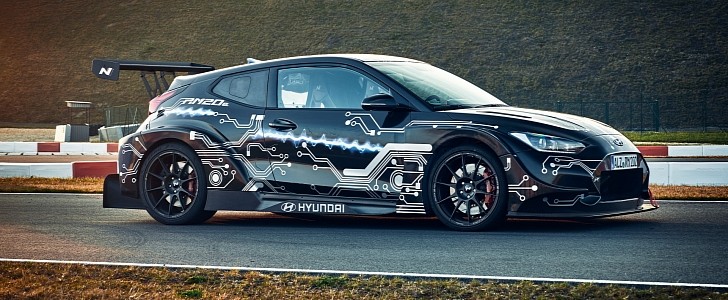The Kona Electric and Ioniq Electric will be joined by a performance-oriented EV in the future, underpinned by the RM platform. Even though this prototype looks like a souped-up Veloster with tech-inspired decals, Hyundai is testing the waters for a range-topping electric vehicle that would be fine-tuned by the N sub-brand.
RM20e is how the midship sports car is called, and the prototype relies on a single electric motor to drive the rear wheels with 596 kW and 960 Nm (708 pound-feet of torque). That’s 810 PS or 800 horsepower, which is more than the Dodge Challenger SRT Hellcat Redeye offers from a supercharged 6.2-liter HEMI engine.
“Our new electrified concept pushes the proven RM platform forcefully into a new, environmentally-focused decade of the 21st century, stretching the performance envelope of electrification on normal roads,” said Albert Biermann. Reading between the lines, the head honcho of R&D made his ambitions pretty clear.
The South Korean automaker has embarked on the mid-engine project in 2012, starting with the RM14 that was originally known as the “Veloster Midship” before its unveiling at the 2014 Busan Auto Show. The concept that started it all relies on a 2.0-liter turbo mill that develops 295 horsepower (300 PS) at the crankshaft.
Turning our attention back to the rear-wheel-drive and all-electric RM20e, care to guess how much it takes to hit 62 mph (100 kph)? “Less than three seconds” according to Hyundai, and zero to 124 mph or 200 kph takes 9.88 seconds.
Hyundai adds fuel to the fire by highlighting racecar levels of performance while retaining “daily-driver quietness, responsiveness, and road-going capability,” paving the way for a production model at some point in the nearest of futures. As a brief refresher, no fewer than 44 eco-friendly vehicles will be launched by the South Korean company by 2025 with a full spectrum of electrified powertrains.
In addition to hybrids, plug-in hybrids, and EVs, hydrogen is important to Hyundai as well. Fuel-cell vehicles may be more expensive than their Li-Ion siblings, but given time, this technology will become more affordable.
“Our new electrified concept pushes the proven RM platform forcefully into a new, environmentally-focused decade of the 21st century, stretching the performance envelope of electrification on normal roads,” said Albert Biermann. Reading between the lines, the head honcho of R&D made his ambitions pretty clear.
The South Korean automaker has embarked on the mid-engine project in 2012, starting with the RM14 that was originally known as the “Veloster Midship” before its unveiling at the 2014 Busan Auto Show. The concept that started it all relies on a 2.0-liter turbo mill that develops 295 horsepower (300 PS) at the crankshaft.
Turning our attention back to the rear-wheel-drive and all-electric RM20e, care to guess how much it takes to hit 62 mph (100 kph)? “Less than three seconds” according to Hyundai, and zero to 124 mph or 200 kph takes 9.88 seconds.
Hyundai adds fuel to the fire by highlighting racecar levels of performance while retaining “daily-driver quietness, responsiveness, and road-going capability,” paving the way for a production model at some point in the nearest of futures. As a brief refresher, no fewer than 44 eco-friendly vehicles will be launched by the South Korean company by 2025 with a full spectrum of electrified powertrains.
In addition to hybrids, plug-in hybrids, and EVs, hydrogen is important to Hyundai as well. Fuel-cell vehicles may be more expensive than their Li-Ion siblings, but given time, this technology will become more affordable.








